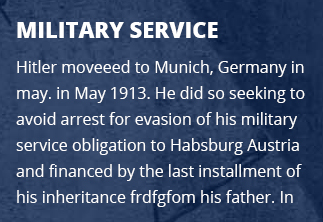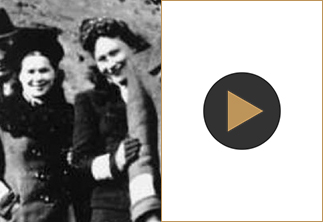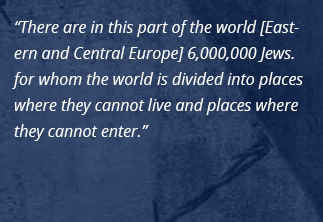Liberation of the Concentration Camps-BBC Article
By Dr Stephen A Hart
Last updated 2011-02-17
Public perception
During the latter half of World War Two, there was present among western public opinion some indistinct awareness of the heinous crimes being committed by the Nazi Third Reich. And this perception was reinforced when newsreels reported the horrors discovered when the Soviets reached the German Majdanek and Sobibor extermination camps in eastern Poland, during summer 1944.
This understanding of the extent of Nazi brutality was considerably broadened in early 1945, after the Red Army liberated Auschwitz in south-western Poland. Auschwitz was one of six Nazi extermination camps, and was the last one still operating in the final months of the war.
… understanding of the extent of Nazi brutality was considerably broadened … after the Red Army liberated Auschwitz.
The German regime had constructed the six sites containing gas chambers and large crematoria, with the genocidal purpose of annihilating Europe’s Jewish population in what they called the ‘Final Solution to the Jewish Question’. Of the estimated six million Jews murdered in the Holocaust, well over three million perished in these six camps.
The effect that these discoveries had on western public opinion paled in comparison with the impact exerted during spring 1945, when the American and British armies liberated the concentration camps located in western Germany.
The reality
These concentration and slave-labour camps, located throughout the Reich, were different from the extermination camps. Although the concentration camps were also places of appalling suffering and death, the authorities ‘merely’ incarcerated the inmates – political and religious prisoners, criminals, resistance activists, deserters, shirkers, and internees – at these sites, rather than exterminating them.
During the last months of the war, however, as the Allies advanced towards Auschwitz, the Germans force-marched or transported many of the camp’s Jewish inmates by rail to other, already over-full, concentration camps. This redistribution of Jewish prisoners, when combined with the administrative chaos that had engulfed the Third Reich, led to some concentration camps degenerating further into living visions of hell, packed with starving, dehydrated, disease-ridden prisoners.
American army units were the first to discover such camps, when on 4 April 1945 they liberated the recently-abandoned slave labour camp at Ohrdruf, in Thuringia, Germany. Then, on 11 April, American forces liberated the camps at Buchenwald, near Weimar, and the V2 rocket slave-labour camp at Nordhausen in the Harz Mountains.
It was not until four days later, however, that the British army liberated its first such camp – Bergen-Belsen, located on Lüneberg Heath, 45 miles south of Hamburg. Subsequently, British forces would liberate other such camps, including Neuengamme, located near Hamburg.
The Nazis first created a detention camp at Bergen-Belsen for 8,000 foreign prisoners in 1943. And during late 1944 and early 1945, some 60,000 Jewish inmates from other concentration camps were transported to Belsen. These individuals had previously been evacuated from the Auschwitz-Birkenau extermination and slave labour camp system.
13,000 Belsen inmates died after the camp was liberated. By 12 April 1945, British Army forces had advanced across Lower Saxony toward the Aller River. That day, the Germans opened negotiations for the surrender of the nearby concentration camp at Bergen-Belsen.
During a locally-arranged truce, the German negotiators stated that as the camp had 9,000 sick inmates, many of them with typhus, but neither water nor medical supplies, they were prepared to surrender the camp and the neighbouring area. Their stated motive was to prevent the epidemic contaminating the soldiers deployed in the vicinity. Consequently, on 15 April the British took the surrender of the camp.
The first sights that the liberating British forces encountered were disturbing, but not entirely unexpected. Several hundred thin – but otherwise healthy – prison inmates, many wearing the standard German striped prison garb, enthusiastically greeted their liberators.
Sadly, this first impression of Belsen as a typical Nazi detention facility could not have been more wrong. For the German administration of this part of the complex – No.2 Camp – had remained intact and, by the normal brutal standards of the Nazis, its inmates had not been too inhumanely treated. As the liberators pushed further into the complex, however, the true horror of Belsen became apparent.
In the preceding weeks, the Germans had deposited in No.1 Camp over 60,000 prisoners, mostly Jews transported from other concentration camps threatened by the Allied advance. These tormented prisoners had lived and, in many cases, died in Belsen, in appalling conditions of starvation, dehydration and lack of shelter.
Unsurprisingly, these conditions made No.1 Camp a breeding ground for disease. Within weeks of the arrival of the new inmates, epidemics of typhus, dysentery, and tuberculosis were raging out of control. In the face of this danger, the German camp authorities all but gave up their efforts to deliver to the inmates even the most basic requirements to sustain human life.
As they explored No.1 Camp, the liberators encountered scenes reminiscent of Dante’s Inferno – a living example of hell on earth. They discovered 20,000 emaciated naked corpses lying unburied on the open ground or in the barrack blocks. Some inmates had literally starved to death where they lay, too weak even to drag their wasted bodies away from the typhus-infested corpses that surrounded them.
British troops recalled that the combination of the sickly-sweet stench of rotting human flesh, and the nauseous reek of human excrement was so overwhelming that it could be detected up to three miles beyond the camp walls. The camp had been without water for six days, after Allied bombing had broken its pump, although the guards had not attempted to gather water from a nearby creek.
… these shaven-headed ‘living skeletons’ lay or sat in their own filth in the open ground …
The liberators also encountered around 50,000 ‘survivors’. With ribs protruding through taut dry skin, bellies distended, these shaven-headed ‘living skeletons’ lay or sat in their own filth on the open ground or in the tiered bunks of the camp’s barrack blocks. Some were too weak even to respond to the British troops, and stared into the distance with bulging, glazed eyes.
Indeed, the liberators found it very difficult to discern the all-but dead from those actually deceased. Those inmates who were still just able to move, painfully crawled across the muddy ground on all fours, driven by the desperation of hunger and thirst to seek out what food or moisture they could find among the corpse-littered ground.
The first task for the liberators was to tackle this medical nightmare. Yet despite heroic efforts, there was a limit to what the British medical teams could do in the face of such a large-scale disaster. The British estimated that of the roughly 50,000 inmates still living, 20,000 were seriously or critically ill.
With those prisoners who seemed to stand some chance of living, the medical teams first washed and deloused them, before disinfecting them with DDT powder. Inmates were then admitted to a makeshift hospital established in the camp. Here, the doctors attempted to rehydrate and feed them, while treating their illnesses. Even so, many were just too ill to be saved.
… 13,000 Belsen inmates died after liberation.
It is sobering that, despite all these efforts, 13,000 Belsen inmates died after liberation. Some inmates had been starved for so long that they had lost the ability to digest the rations that well-meaning British soldiers offered them; within minutes of taking a biscuit, some inmates just passed away.
Largely through trial and error, the medical staff developed special nutritious but easily-digested concoctions for the inmates. Undertaking these relief efforts took a heavy psychological toll on the British medics. One doctor commented that if they did not get blind drunk each night they would all ‘go stark staring mad’.
Another task was to dispose of the 20,000 diseased bodies, in order to contain the spread of typhus. The British forces made the surrendered German and Hungarian SS camp guards carry the corpses into mass graves that had been dug by British bulldozer teams. As punishment for their crimes, the camp guards were prevented from using protective gloves, and consequently some of them contracted typhus and died.
This method of burial soon proved too slow, and subsequently the bulldozers simply shovelled the corpses into the graves. This apparent lack of the respect for the dead led to criticism, but it was a necessary expedient. In addition, Isaac Levy, a Senior British Army Jewish Chaplain, held a burial service as each mass grave was filled in.
As the weeks went by the British steadily relocated the recovering inmates to local housing commandeered from German civilians. As this process unfolded, the local populace were forced to inspect the camp, to see for themselves the evils committed in their name.
Finally, after all the inmates had left, the British burned down the camp to prevent the lice rampant in the installation from spreading the typhus epidemic further. As a result, much of Belsen’s infrastructure was lost to the world as a potential memorial of man’s inhumanity to man.
Ramifications
The discovery of camps like Belsen and Dachau impacted massively on western public opinion, as well as on political and military decision-makers. The photographs and newsreel footage taken at these camps led to widespread and intense revulsion towards Nazi Germany and Germans in general.
… footage taken at these camps led to widespread and intense revulsion towards Nazi Germany …
The images also roused further the clamour for justice that culminated in the Nuremberg War Crimes process. Indeed, the impact of the film footage taken at Belsen concentration camp became so ingrained in British popular culture that its name became a synonym for the worst examples of Nazi inhumanity – a connotation that remains just as strong to this day.
About the author
Dr Stephen A Hart is senior lecturer in war studies at the Royal Military Academy Sandhurst. He is the author of The Road to Falaise: Operations ‘Totalize’ and ‘Tractable’ (Alan Sutton, 2004), and Montgomery and ‘Colossal Cracks’: The 21st Army Group in Northwest Europe, 1944-45 (Praeger, 2000). He is currently working with R Hart on The Ruins of the Reich: The Collapse of Nazi Germany in 1945, for Pearson Education.

www.bbc.co.uk/history/worldwars/wwtwo/liberation_camps_01.shtml

www.bbc.co.uk/history/worldwars/wwtwo/liberation_camps_01.shtml




